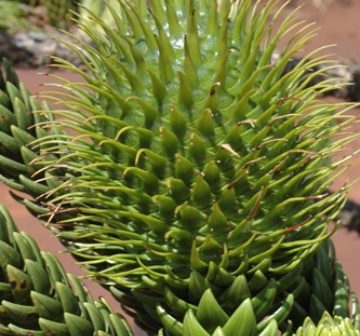Araucariaceae
Araucaria rulei
One of 13 species of Araucaria endemic to New Caledonia (Grande Terre) where it has suffered a severe decline due to nickel mining and associated activities
Description
Habit
A monoecious tree up to 25m tall, with a d.b.h. up to 0.8m when fully mature; pyramidal when young and developing a very distinct open, candelabriform crown as it matures. Bark thick, light grey to almost white, often peeling in horizontal plates.
Foliage
Adult leaves lanceolate to ovate with an acute apex, 1–2.5 x 1–2cm, upper surface glossy, stomata confined to near the base. Foliage clustered on small branches at the end of primary branches.
Cones
Female seed-cones borne terminally on very short branches; mature cones broadly ovoid, up to 12cm long; bracts with a prominent tip; cones ripening January and February. Male pollen-cones terminal, 8–25cm long; maturing from July to August.
Key characters
Araucaria rulei resembles A. muelleri in its candelabriform crown with long, laxly arranged horizontally spreading primary branches always in whorls of 4, and very pale, almost white bark. The smaller leaves and denser phyllotaxis (usually 6 leaves visible per half-spiral) distinguishes A. rulei from A. muelleri; A. rulei also has a glossy upper surface to the adult leaves which almost lack stomata except for very near the base.
References and further reading
- Cornu, A., Sarrailh, J.-M. & Marion, F. (2001). Espèces endémiques et restauration écologique en Nouvelle-Calédonie. Bois Et Forêts Des Tropique 268(2): 57-68.
- de Laubenfels, D. J. (1972). Gymnospermes. In: Aubréville, A. & Leroy, J.-F. (eds.), Flore de la Nouvelle-Calédonie et Dépendances, 4. Paris: Muséum National d’Histoire Naturelle. 167 p.
- Gaudeul, M., Rouhan, G., Gardner, M.F. & Hollingsworth, P.M. (2012). AFLP markers provide insights into the evolutionary relationships and diversification of New Caledonian Araucaria species (Araucariaceae). American journal of Botany 99(1):68-81.
- Jaffré, T., Munzinger, J. & Lowry, P.P. (2010). Threats to the conifer species found on New Caledonia's ultramafic massifs and proposals for urgently needed measures to improve their protection. Biodiversity and Conservation 19(5):1485-1502.
- L'Huillier, L. Jaffré,T. & Wulff A. (2010). Mines et environnement en Nouvelle-Calédonie : les milieux sur substrats ultramafiques et leur restauration. Editions IAC, Nouméa, Nouvelle-Calédonie, 412 p.
- Manauté, J., Jaffré, T., Veillon, J.–M. & Kranitz, M. (2003). Revue des Araucariaceae de Nouvelle-Calédonie. IRD, Nouméa
- Mazzeo, F. (2004). Exploitation minière et valorisation du patrimoine floristique de Nouvelle-Calédonie. Contribution à l’élaboration d’un guide pratique de reboisement des terrains miniers du Grand Sud (Sud de la ligne Mont-Dore‐Yaté). Saint Denis: Université de La Réunion / Noumea: IRD. 75 pp.
- Nasi, R. (1982). Essai pour une meilleure connaissance et une meilleure comprehension des Araucariacées dans la végétation Calédonienne. Nouméa: École Nationale des Ingénieurs des Travaux des Eaux et Forêts, Centre Technique Forestier Tropical. 134 p., 10 plates, 44 p. appendices.
- Thomas, P. (2010). Araucaria rulei. In: IUCN 2012. IUCN Red List of Threatened Species. Version 2012.1. www.iucnredlist.org. Downloaded on 29 June 2012.











